Having trees in your yard is awesome. Not only do they increase the beauty of your house, but they also purify the air we breathe. However, trees come with disadvantages too. They can make your yard messy, especially during fall and autumn when dealing with fallen leaves can become quite challenging. Fortunately, we have the perfect solution for this tedious chore. In this article, we’re going to show you the best way to clean up leaves in a large yard.
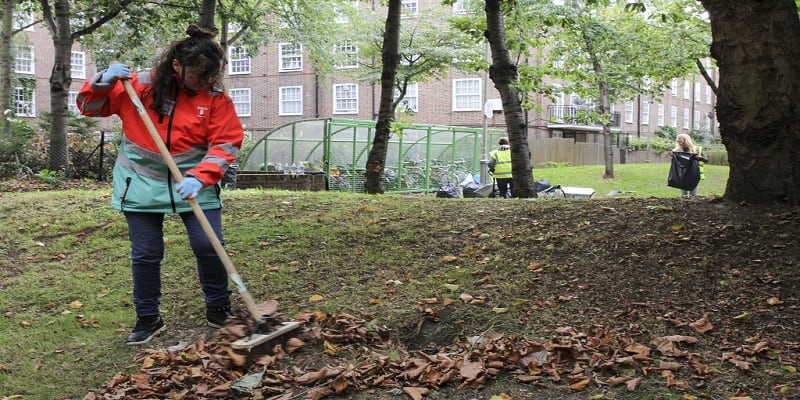
Firstly, Let’s Understand:
Why Cleaning Up Leaves in Large Yards Matters
Dealing with fallen leaves in a big yard can be a tough job. It’s more than just making your yard look nice – it’s about keeping your lawn healthy and safe. When you have a lot of space to cover, finding the best way to clean up leaves becomes really important.
Leaves that pile up can cause problems for your grass. They block sunlight and trap moisture, which can lead to lawn diseases and dead patches. In fall and winter, these leaf piles can also attract pests looking for a cozy home. Plus, wet leaves on walkways can be slippery and dangerous.
But cleaning up leaves in a large yard isn’t easy. It takes time, effort, and the right approach. This guide will help you find the best ways to tackle this big task, making your yard work easier and more effective.
Getting to Know Your Yard and Leaf Situation
Before you start cleaning up leaves, it’s smart to understand what you’re dealing with. This will help you choose the best tools and methods for your specific yard.
How Big Is Your Yard?
First, figure out how much space you need to clean. Is your yard half an acre? A full acre? More? Knowing this helps you plan how much time you’ll need and what tools will work best.
What Kind of Trees Do You Have?
Different trees drop different amounts of leaves. Some things to think about:
- Big trees like oaks and maples usually drop more leaves
- Evergreen trees, like pines, drop needles all year round
- Some trees, like birches, have smaller leaves that are harder to pick up
Knowing your trees helps you guess how many leaves you’ll have to deal with.
What’s Your Yard Like?
Look at the layout of your yard:
- Is it mostly flat, or does it have hills?
- Are there lots of plants, flower beds, or bushes to work around?
- Do you have paths, a patio, or other areas that need special care?
These details will affect how you clean up your leaves.
Tools for Cleaning Up Leaves in Big Yards
Having the right tools can make leaf cleanup much easier and faster. Here are some top choices for dealing with leaves in large yards:
Leaf Blowers
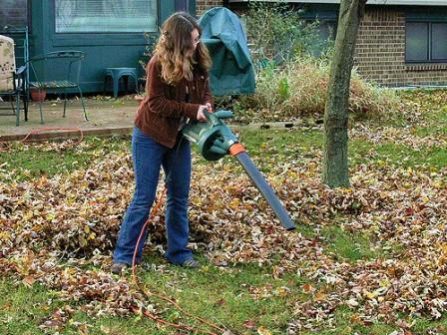
Leaf blowers use strong air currents to move leaves quickly. They come in different sizes and power levels to suit various yard sizes and leaf amounts. There are three main types:
Handheld blowers: These are lightweight and easy to use. They work well for small yards or quick cleanups. Most run on electricity or battery power, making them quieter than gas models.
Backpack blowers: These are more powerful and easier to carry for longer periods. They’re great for medium to large yards. The backpack design spreads the weight across your shoulders, reducing arm strain during long jobs.
Wheeled blowers: These are the most powerful type. They’re best for very large areas with lots of leaves. While they can clear leaves fast, they’re bulky and harder to move around obstacles.
See Here: Best Leaf Blowers
Good things:
- Move leaves very quickly
- Can reach tight spots like under bushes
- Work well for large open areas
Not-so-good things:
- Can be very noisy
- Might disturb neighbors
- Don’t work well on wet or heavy leaves
- Gas-powered models create air pollution
Rakes
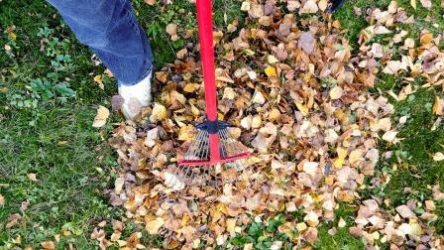
Rakes are simple tools that have been used for leaf cleanup for a long time. They come in different styles to suit various tasks:
Standard leaf rakes: These have a wide, fan-shaped head with flexible tines. They’re good for most leaf-raking jobs and work on different surfaces like grass, gravel, or pavement.
Adjustable rakes: These rakes can change their width. This feature lets you work in both open areas and tight spaces with the same tool. They’re versatile for yards with varied landscaping.
Hand rakes: These small rakes are perfect for working in flower beds, around delicate plants, or in tight spaces where larger rakes can’t fit. They give you more control for detailed work.
Good things:
- Don’t make noise or use fuel
- Provide good exercise
- Can be used on any type of leaf or surface
- Affordable and easy to store
Not-so-good things:
- Take more time and effort than power tools
- Can cause blisters or muscle soreness
- Not efficient for very large areas
Leaf Vacuums and Mulchers
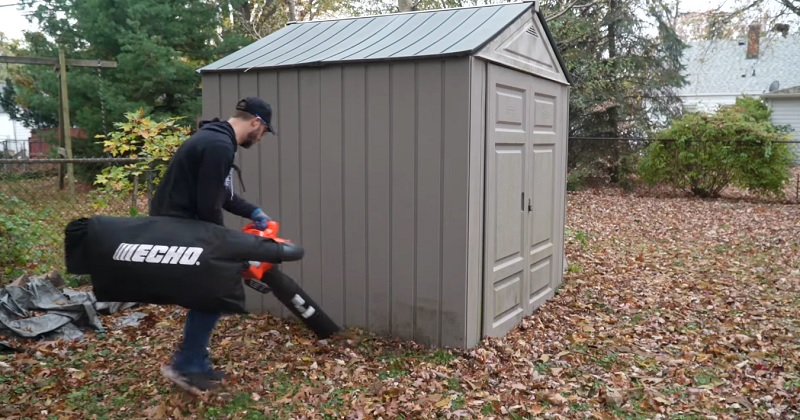
These tools suck up leaves and often chop them into smaller pieces. This process, called mulching, can reduce leaf volume significantly. Some models can shred leaves to one-tenth of their original size:
Good things:
- Collect and shrink leaf piles at the same time
- Create mulch you can use in gardens
- Work well in areas with many leaves
- Can pick up small twigs and debris too
Not-so-good things:
- Often heavier than leaf blowers
- May get clogged by wet leaves or large twigs
- Can be expensive, especially for good quality models
- Bagging mechanisms may need frequent emptying
Riding Mowers with Leaf Collection Systems
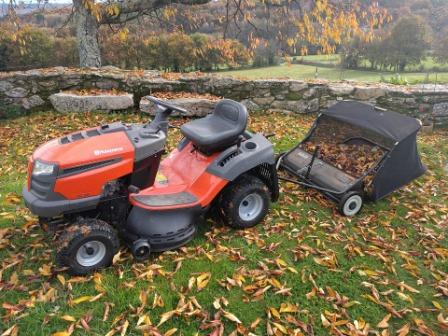
For very large yards, a riding mower with a leaf collection system can be a big help. These machines combine the grass-cutting ability of a mower with leaf pickup:
Good things:
- Cover large areas quickly
- Comfortable to use for long periods
- Can mow grass and collect leaves at the same time
- Often have large collection bags, reducing emptying frequency
Not-so-good things:
- Very expensive compared to other leaf cleanup tools
- Need a lot of storage space
- May be too large for yards with many obstacles
- Require regular maintenance
Tarps and Leaf Collection Bags
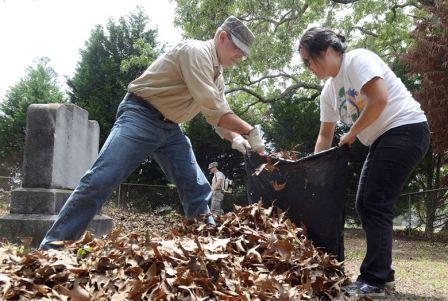
While not powered tools, tarps and leaf collection bags are very helpful for leaf cleanup:
Tarps: Large, flat sheets of strong material. They’re great for moving big piles of leaves. You can rake or blow leaves onto a tarp, then drag it to your compost pile or collection area.
Collection bags: These come in different sizes and materials. Some are designed to stand up on their own, making it easier to fill them with leaves. Others are more like large sacks that you can drag around the yard.
Good things:
- Affordable and easy to store
- Make moving large amounts of leaves easier
- Can be used with any leaf collection method
- Reusable options are environmentally friendly
Not-so-good things:
- Dragging heavy tarps can be tiring
- Plastic bags are not eco-friendly if thrown away
- Can be awkward to use in windy conditions
- May tear if overfilled or caught on sharp objects
Best Ways to Clean Up Leaves in Large Yards
Now that you know about your yard and tools, let’s look at some good ways to clean up leaves:
Blow and Pile Method
This method uses a leaf blower to make big piles of leaves. Start at one end of your yard and blow leaves into long rows. Then, push these rows together to make larger piles. Finally, use a tarp or vacuum to collect the piles.
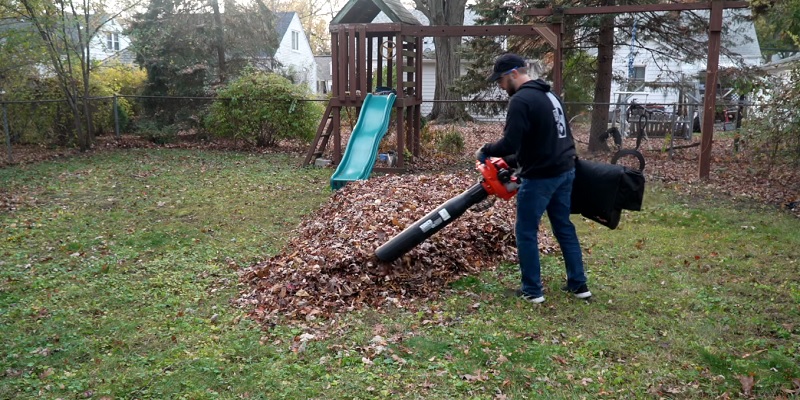
This works well for very large, open areas and yards without many things in the way. For the best results, work with the wind, not against it. Blowing leaves onto tarps makes them easier to move. Your back will feel better if you do it this way!
Mow and Mulch Approach
You can turn leaves into food for your plants by mowing over them. Set your mower to cut high, then mow over the leaves to chop them into small pieces. Let these bits fall onto your lawn.
This is good for yards that don’t have too many leaves and for people who want to feed their lawn naturally. It works best when leaves are dry. You might need to mow over areas more than once to cut the leaves small enough. It’s like making a healthy snack for your grass!
Raking Strategies
For a more traditional approach, try these raking tips. Rake leaves into rows, just like you’re mowing. Then push these rows together to form piles. Finally, rake the leaves onto tarps or into bags for disposal or composting.
This method works well for smaller yards and areas with lots of plants or obstacles. To avoid getting tired, use your whole body, not just your arms, when raking. It’s best to rake when leaves are dry – they’re lighter and easier to move.
Vacuum and Mulch Approach
Using a leaf vacuum can be quick and tidy. Start in one corner of your yard and move in straight lines, like you’re mowing. Remember to empty the collection bag when it gets full.
This approach is great for medium-sized yards and people who want to collect leaves for compost. Before you start, check for sticks or stones that might damage the vacuum. Working in sections helps you keep track of your progress.
Combo Method for Big Yards
For very large yards, try combining different methods. Use a blower for open areas to quickly move leaves. Rake around plants and in tight spots where the blower can’t reach. Finish by mowing to mulch any leftover leaves.
This mixed approach works well for yards larger than an acre and areas with different types of spaces. Before you start, plan how you’ll clean up each part of your yard. Remember to take breaks to avoid getting too tired.
Each of these methods has its strengths. Choose the one that fits your yard size, the amount of leaves, and the tools you have. You might find that a mix of methods works best for your specific situation. The key is to find an approach that keeps your yard clean without wearing you out.
Here’s our personal preference: we found comfort in the blow and pile method. It’s the easiest, fastest, and best way to clean up leaves in a large yard. This approach offers efficiency and simplicity for tackling extensive leaf-covered areas.
Step-by-Step Guide to Cleaning Up Leaves
Here’s a detailed plan to tackle your leaf cleanup:
Plan Your Approach
First, let’s check the weather. We want a nice dry day for leaf cleaning. Think about which methods will work best for your yard and how many leaves you have. Get all your tools ready before you start – it’ll save you time running back and forth!
Section Your Yard
Big jobs can feel overwhelming, right? Let’s break your yard into smaller parts. It’ll feel much more doable that way. Start with the windy spots – they usually have the most leaves.
Clear Paths and High-Traffic Areas First
Let’s focus on cleaning walkways, driveways, and patios early on. This stops leaves from being dragged around and makes the rest of your yard work easier.
Work in a Pattern
Move in straight lines or circles as you clean. It’s like mowing the lawn – it helps make sure we cover everything and don’t miss any spots.
Create Collection Points
Put tarps or bags in handy spots around your yard. It’s like setting up leaf “bus stops” – it saves time when moving leaves and means less walking for you.
Deal with Piles Quickly
Try not to leave leaf piles sitting around. Wet piles are a pain to move and can hurt your grass. Let’s bag or move leaves as soon as we make a pile.
Clean Up as You Go
Empty your bags or tarps often. It’s no fun trying to move heavy loads at the end when you’re tired.
Finish with a Final Check
Let’s take a quick walk around the yard to check for any missed spots. Don’t forget to peek in corners and along fences – leaves love to hide there!
Time-Saving Tips for Big Yard Leaf Cleanup
Cleaning up leaves in a large yard can eat up a lot of time. Here are some ways to speed up the process:
Pick the Right Time
Clean up leaves weekly during peak fall season. This stops leaves from piling up too much and makes each cleanup session quicker.
Use the Wind
Try to work on windy days when leaves are dry. Let the wind help blow leaves in the direction you want, saving you effort.
Create Leaf Stations
Set up collection spots around your yard. This cuts down on how far you need to move leaves, saving time and energy.
Get Help
Ask family members to join in the leaf cleanup. For very large jobs, you might want to hire help to speed things up.
Use Multiple Tools
Start with a blower for big, open areas. Then switch to a rake for detailed work around plants or in tight spaces.
Mow High and Often
Mowing leaves into small pieces can save bagging time. Do this regularly to stop leaves from building up too much.
Eco-Friendly Ways to Use Leaves
Instead of bagging all your leaves, try these green options:
Composting Leaves
Leaves make great compost material. Collect dry leaves in a bin or pile, then mix them with green materials like grass clippings. Keep the pile damp and turn it now and then. In a few months, you’ll have rich compost for your garden.
Mulching with Leaves
Use leaves to protect your plants. Shred leaves with a mower or mulcher, then spread a 2-3 inch layer around plants and trees. This helps keep water in the soil and stop weeds from growing.
Making Leaf Mold
Leaf mold is great for improving soil. Pile up leaves in a corner of your yard and keep the pile damp. Wait 6-12 months, then use the dark, crumbly material to make your soil better.
Keeping Your Yard Leaf-Free All Season
Regular care can make leaf cleanup easier:
Set a Schedule
Plan to clean up leaves once a week during fall. This stops big piles from forming, which are harder to deal with.
Use Preventive Measures
Put leaf guards on gutters to keep them clear. If you have a pond or pool, think about using a leaf net to keep leaves out.
Trim Trees and Bushes
Regular pruning can reduce how many leaves fall. This means less cleanup work for you in the long run.
Mulch Leaves Regularly
Use your mower to chop up leaves often. This can reduce the need for big cleanups and feed your lawn at the same time.
By following these steps and tips, you can keep your yard leaf-free with less effort. Remember, consistent small efforts often work better than waiting for a big leaf pile to form.
Staying Safe While Cleaning Up Leaves
Safety should always come first when doing yard work. Here are some important tips to keep in mind:
Wear the Right Gear
Protect your hands with sturdy gloves to avoid blisters and cuts. Wear closed-toe shoes with good grip to prevent slips and falls. Use eye protection, especially when using leaf blowers or vacuums, to shield your eyes from flying debris.
Use Good Posture
When lifting bags or piles of leaves, bend at your knees, not your waist. This protects your back from strain. If you’re raking, switch sides often to balance the work across your body and avoid overusing one set of muscles.
Stay Hydrated
Even in cool fall weather, it’s important to drink plenty of water. Yard work is exercise, and your body needs fluids to stay healthy and avoid fatigue.
Be Careful with Equipment
If you’re using power tools, read the manual first to understand how to use them safely. Keep electrical cords away from your work area to avoid tripping or accidentally cutting them.
Watch for Pests
Leaf piles can be home to insects, small animals, or even snakes. Be aware of what might be hiding in the leaves and approach piles with caution.
DIY vs. Hiring Help: What’s Best for You?
Deciding whether to clean up leaves yourself or hire help depends on several factors. Let’s look at the good and not-so-good points of each option:
Doing It Yourself
Cleaning up leaves on your own can save money. It’s also good exercise and allows you to take care of your yard whenever you want. However, it takes a lot of time and can be physically tiring. You’ll also need to buy and store equipment, which can be costly and take up space.
Hiring Professional Help
Getting professionals to clean your leaves saves time and effort. They have efficient equipment and can handle very large jobs quickly. But hiring help costs more money than doing it yourself. You also have less control over when and how the work is done. Professional services might not know your yard’s specific needs as well as you do.
Making Your Choice
To decide what’s best for you, think about these things:
How big is your yard? Larger yards take more time and effort to clean.
How much free time and energy do you have? Leaf cleanup can be time-consuming and physically demanding.
What’s your budget? Consider both the cost of buying equipment and the price of professional services.
For very large yards, a mix of both approaches might work best. You could handle regular maintenance yourself and bring in professionals for big seasonal cleanups.
Remember, there’s no one-size-fits-all answer. The best choice depends on your specific situation, preferences, and resources. Whether you do it yourself or hire help, the goal is to keep your yard healthy and looking good without causing yourself stress or financial strain.
Final Words
So, this is our step-by-step guide on the best way to clean up leaves in a large yard. When dealing with large yards, patience is the number one key. If you have a significantly large yard, we highly suggest investing in a decent mower. Though it can be pricier than leaf blowers, mowers are far more efficient for large areas.
One more alternative way is to rent a yard vacuum from the local gear rental. It will be particularly helpful if you have low storage space and only need to use the vacuum for a few days every spring and fall. This way, there’s no need to spend a fortune on a mower or a leaf blower.
Common Questions About Leaf Cleanup in Large Yards
How often should I clean up leaves in a large yard?
For big yards, try to clean up leaves once a week during the main falling season. This keeps the job manageable and prevents leaf buildup that can harm your lawn.
What’s the fastest way to clean up leaves in a large yard?
Using a combination of methods is usually fastest. Start with a leaf blower for open areas, use a rake for spots around plants and obstacles, and finish by mulching with a mower.
Is it better to rake or blow leaves?
It depends on your yard. Blowing is faster for large, open areas. Raking works better for smaller spaces or yards with lots of plants and obstacles. Many people use both for the best results.
How can I make leaf cleanup less time-consuming?
Try these tips:
- Clean up regularly to avoid big piles
- Use the right tools for your yard size
- Work with the wind
- Set up leaf collection stations around your yard
- Get help from family or consider hiring services for part of the job
Are there any benefits to leaving some leaves on the ground?
Yes! A thin layer of leaves can be good for your yard. They add nutrients to the soil as they break down and provide shelter for beneficial insects. Just make sure the layer isn’t thick enough to smother your grass.


